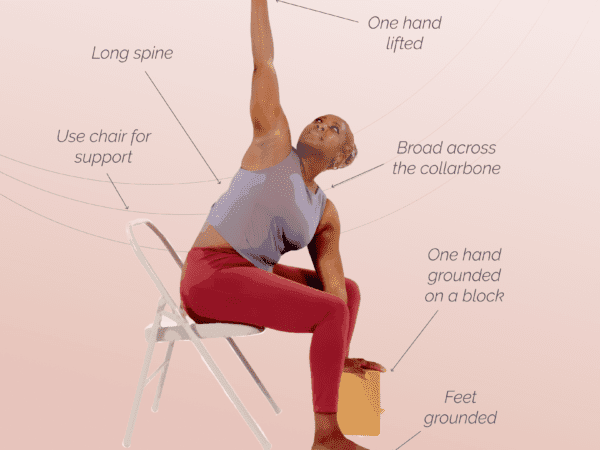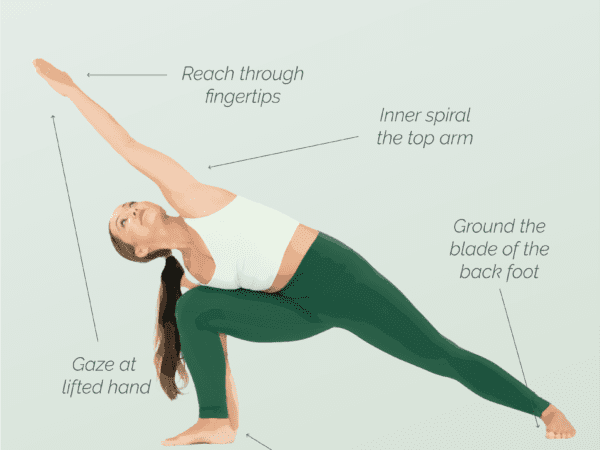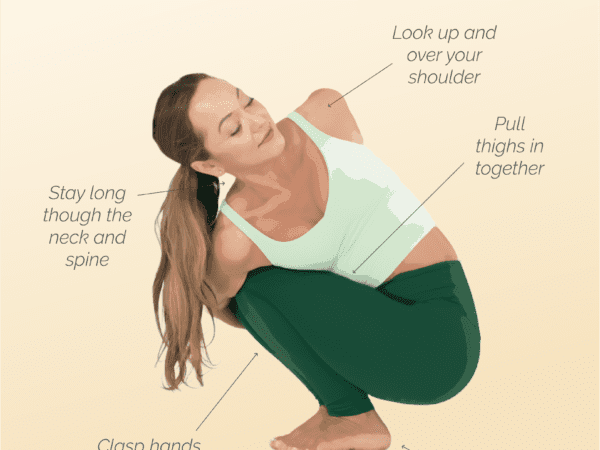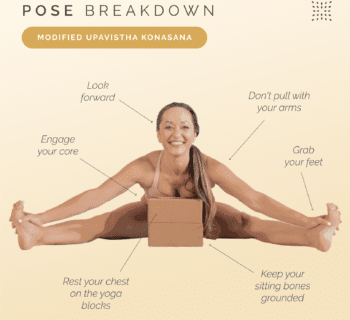The modified side plank is one of the variations of side plank that you can do if your have difficulty doing the traditional plank pose. This powerful yoga pose that strengthens your core, improves balance, and increases flexibility. Practicing it can help your level up your fitness. Whether you’re a beginner or an experienced yogi, this variation of the side plank is accessible and can be modified to suit your individual needs. In this guide, we’ll walk you through the steps to master the modified side plank, providing clear instructions and tips along the way. Get ready to challenge yourself and experience the transformative benefits of this empowering yoga pose. Let’s dive in!
What muscles does a modified side plank target?
Modified side plank is a fantastic yoga pose that targets multiple muscles in the body. While the traditional side plank primarily strengthens the core and obliques, the modified version offers a more accessible variation suitable for beginners or those with limited mobility who are building strength. Let’s dive into the muscles that the modified side plank targets and the benefits it can provide.
1. Core muscles: The modified side plank engages the deep core muscles, including the transverse abdominis and the internal and external obliques. These muscles are responsible for stabilizing the spine and improving posture. By practicing this pose regularly, you can strengthen your core, enhance your stability, and prevent lower back pain.
2. Gluteus medius: The modified side plank activates the gluteus medius muscle, located on the outer side of your hip. This muscle helps stabilize the pelvis, supports hip abduction (moving your leg away from the midline), and contributes to better balance. Strengthening the gluteus medius can benefit everyday activities like walking, running, and standing.
3. Shoulder muscles: When performing the modified side plank, you engage the muscles of the shoulder girdle, including the deltoids, trapezius, and serratus anterior. These muscles work together to stabilize and support the shoulder joint, enhancing upper body strength and stability.
4. Quadratus lumborum: This deep muscle located in the lower back is also activated during the modified side plank. Strengthening the quadratus lumborum can help improve spinal stability and support, reduce lower back pain, and enhance overall posture.
Benefits of practicing the modified side plank
Incorporating the modified side plank into your yoga practice can offer numerous benefits for both the body and mind. Some of the key benefits include:
1. Core strengthening: As mentioned earlier, the modified side plank targets the core muscles, including the transverse abdominis and obliques. By strengthening these muscles, you can improve your overall core stability, support your spine, and enhance your balance.
2. Increased flexibility: The modified side plank also helps improve flexibility, particularly in the hips and shoulders. As you hold the pose, you’ll feel a gentle stretch in these areas, helping to release tension and increase range of motion.
3. Improved posture: Regular practice of the modified side plank can contribute to better posture. As the core and back muscles become stronger, they can better support the spine and maintain proper alignment, reducing the risk of slouching or hunching.
4. Enhanced balance: The modified side plank challenges your balance, as you have to support your body weight on one arm and leg. By practicing this pose regularly, you can improve your proprioception (awareness of your body in space) and overall balance.
5. Strengthened shoulders: The shoulder muscles, including the deltoids, trapezius, and serratus anterior, are actively engaged in the modified side plank. Regular practice can help strengthen these muscles, enhancing upper body strength and stability.
6. Reduced lower back pain: Strengthening the quadratus lumborum, a deep muscle in the lower back, can help alleviate lower back pain and improve spinal stability.
7. Increased mental focus: The modified side plank requires concentration and focus to maintain the pose. By practicing this pose, you can enhance your mental clarity and improve your ability to stay present in the moment.
Contraindications for modified side plank
While the modified side plank is generally a safe and beneficial yoga pose, there are certain contraindications and precautions to keep in mind. It’s important to listen to your body and consult with a qualified yoga instructor or healthcare professional if you have any concerns or pre-existing conditions. Here are some contraindications for practicing the modified side plank:
- Wrist or shoulder injuries: If you have a wrist or shoulder injury, it’s important to be cautious when practicing the modified side plank. Putting weight on an injured wrist or shoulder can exacerbate the condition and potentially cause further damage. Consider modifying the pose or avoiding it altogether until you have fully recovered.
- High blood pressure: If you have high blood pressure or any cardiovascular conditions, it’s advisable to avoid practicing the modified side plank. This pose can increase blood flow and put additional strain on the cardiovascular system, potentially leading to complications. It’s best to consult with your healthcare provider for guidance on suitable modifications or alternative poses.
- Pregnancy: While the modified side plank can be modified for pregnant women, it’s crucial to consult with your healthcare provider before attempting this pose. Pregnancy brings about significant changes in the body, and modifications may be necessary to ensure the safety of both the mother and the baby. Always prioritize the guidance of your healthcare provider and listen to your body’s needs.
- Recent abdominal surgery: If you have recently undergone abdominal surgery, such as a hernia repair or C-section, it’s important to avoid putting strain on the abdominal muscles. The modified side plank requires engagement of the core muscles, which may not be suitable during the healing process. Consult with your healthcare provider for guidance on when it is safe to resume practicing this pose.
- Wrist or elbow pain: If you experience pain or discomfort in your wrists or elbows, it’s advisable to modify the modified side plank or choose alternative poses that do not put excessive pressure on these joints. Protecting and respecting your body’s limitations is essential to prevent further injury or aggravation.
How to practice the modified side plank
Follow these steps to practice the modified side plank:
Start on your hands and knees in tabletop pose. Make sure your shoulders are stacked over your wrists.
Keep your left leg bent and straighten your right leg.
Pivot so you turn your body to the side. Your left foot is pointed behind you.
Lift you left arm straight up to the ceiling.
Stack your hips, so your body is sideways.
Your right leg is straight and pointing to the back of the mat and your left leg is bent to 90 degrees with the foot pointed behind you to the side of the mat.
Stretch up through your right arm and gaze up at your hand. Press your left hand into the floor. Be careful not to hyperextend your elbow.
Activate your core to keep your body steady.
Hold the pose for 30 seconds to 1 minute, or as long as you can comfortably maintain proper form.
Repeat on the other side.
Tips and modifications
– If you have wrist pain, you can practice the modified side plank on your forearm instead of your hand.
– To deepen the pose, you can lift your top leg off the ground and extend it straight out.
– If you have neck discomfort, you can look down instead of up towards the ceiling.
– Remember to breathe deeply and maintain proper alignment throughout the pose.
How often should a modified side plank be done?
Modified side plank is a fantastic yoga pose that helps strengthen and tone your core, arms, and legs. It also improves balance and stability. As with any yoga pose, the frequency with which you practice modified side plank depends on your personal goals and abilities. However, it is generally recommended to incorporate it into your yoga routine at least 2-3 times per week for optimal results.
If you are new to yoga or have limited upper body strength, it is important to start slowly and gradually increase the frequency and intensity of your modified side plank practice. Begin by holding the pose for 10-15 seconds on each side and gradually work your way up to 30 seconds or longer as you build strength and stability.
For those with more experience and strength, you can incorporate modified side plank into your practice on a daily basis or even multiple times a day. However, it is crucial to listen to your body and avoid overexertion or strain. If you experience any pain or discomfort, it is advisable to take a break and consult a qualified yoga instructor or healthcare professional.
Remember, consistency is key when it comes to reaping the benefits of any yoga pose. By practicing modified side plank regularly, you will gradually improve your strength, flexibility, and overall yoga practice. With consistent practice, you may work your way up to doing other versions of plank pose. So, whether you choose to do it a few times a week or more frequently, make sure to enjoy the process and honor your body’s needs. Happy side planking!
Are you looking for more guidance on your yoga journey? Sign up for Omstars to get access to thousands of yoga classes in the comfort of your own home. Click here to start your subscription.









